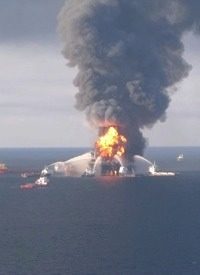
At the site of the worst oil rig disaster in almost a decade, oil continued leaking nearly a mile underwater as of April 25. The Deepwater Horizon rig exploded on April 20 about 50 miles off the Louisiana coast as it was capping a discovery well pending production, company officials said. Eleven workers on board at the time remain missing and are presumed dead; 115 were rescued.
After the rig finally sank on Thursday, the oil spill was originally thought to be manageable. But on Saturday officials discovered two leaks, which they estimate are releasing oil at about 1,000 barrels — or 42,000 gallons — daily, escalating the situation into a major environmental problem.
Previously, rough seas had interfered with cleanup efforts on April 24 and most of Sunday, the 25th. The weather cleared Sunday afternoon, however, and aircraft resumed dumping dispersant chemicals to break down the oil. There were 15 vessels headed to the area by the evening in order to resume skimming off the surface oil. By the 25th, some 48,000 gallons of oil-water mix had been gathered, according to the Coast Guard.
But also by Sunday, the growing oil spill was covering about 600 square miles. If it reaches land the impact would be far-reaching, as it would threaten the Gulf coast’s fragile ecosystem of coral, shrimp, birds, and fish. Weather patterns indicate that the oil sheen should stay about 30 miles from shore until about mid-week. Gulf States have been alerted, with Louisiana already beginning to erect containment booms as a safety measure to protect its delicate coastal areas.
According to reports, the spill was still about 70 miles from the mainland, but it was only about 30 miles from an important chain of barrier islands known as the Chandeleurs, part of a national wildlife refuge and an important nesting ground for pelicans and other sea birds. By washing out much of the sand, Hurricane Katrina had left the area vulnerable.
At a news conference on Sunday, April 25, Rear Adm. Mary E. Landy, commander of the Eighth Coast Guard District, said that, “Everyone is forward-leaning and preparing for coastal impact.”
It was Saturday when the leaks were discovered in the bottom section of the “riser,” the 5,000-foot-long pipe that extended from the wellhead — where the oil emits from the ocean floor — to the actual drilling platform. When the platform exploded and sank, the riser came loose and is now undulating from the wellhead to the sea floor. It is the kinks in the riser that appear to have kept an all-out oil gush from happening. The giant plumes of fire that could be seen last week before the platform sank, came from the oil and gas flowing out of the riser.
On Sunday morning, officials began using remote-controlled vehicles — robot submarines — to try to engage the blowout preventer to shut off the oil. The preventer is a 450-ton valve sitting at the wellhead, 5,000 feet below the ocean’s surface. It is designed especially for this shut off work — so as to prevent sudden pressure releases. It is suspected that such a pressure release was the cause of the first explosion on the oil rig Tuesday night.
But Doug Suttles, the chief operating officer for exploration and production for London-based BP (which was leasing the Deepwater platform and is responsible for the cleanup under federal law) cautioned that the operation was not easy.
“I should emphasize this is a highly complex operation being performed at 5,000 feet below the surface and it may not be successful,” he said.
BP has moved another deepwater rig called the DD3, towards the site of the explosion as a backup. The plan is for this new rig to drill relief wells into the damaged well under the ocean floor itself. This, however, might take several months.
Another plan according to Suttles, is to lower a large dome to the wellhead and capture the oil using pipes and hoses to pump it into a vessel on the surface. This at least would control the flow of oil while more permanent repairs are put in place.
“That system has been deployed in shallower water,” he said, “but it has never been deployed at 5,000 feet of water, so we have to be careful.”
Besides the robot submarines, BP said the response it activated to manage the spill includes 700 workers, four planes and 32 vessels. Other equipment was also brought in by the Marine Spill Response Corporation, an energy industry cleanup consortium.
Mark Schexnayder, a regional coastal adviser at the Louisiana Sea Grant, commented that the location of the spill is crisscrossed by marine species, including sperm whales, whale sharks, sea turtles, grouper, and porpoises. He added, “We’re a month away from opening up the inshore shrimp season — crab season is just getting underway. It could close oyster beds.”
The worst spill in U.S. history was the Exxon Valdez in 1989, dumping 11 million gallons of oil into Alaska’s Prince William Sound. Officials here believe they are far from exceeding that disaster.
Photo: Fire boat response crews battle the blazing remnants of the off shore oil rig Deepwater Horizon Wednesday April 21, 2010: AP Images



